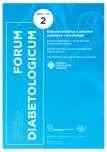Diabetes mellitus and oligosymptomatic arrhythmias: how can we use an implantable ECG loop recorder?
Authors:
Petra Určíková
Authors‘ workplace:
Oddelenie arytmií Stredoslovenský ústav srdcových a cievnych chorôb, a. s., Banská Bystrica
Published in:
Forum Diab 2021; 10(2): 93-97
Category:
Overview
Diabetes mellitus is one of the most common chronic diseases and is currently considered one of the most important risk factors for cardiovascular disease. Although the main cardiovascular complication associated with diabetes mellitus is coronary artery disease, its contribution to heart rhythm disorders is also not negligible. The relationship between diabetes mellitus and arrhythmias is complex and multifactorial. The most common arrhythmia in patients with diabetes mellitus is atrial fibrillation. In patients with atrial fibrillation, diabetes mellitus is one of the risk factors for thromboembolism, especially stroke. Atrial fibrillation, as well as the arrhythmogenic cause of syncope of unclear etiology or clinically significant palpitations, can be examined through continuous ECG monitoring using an implantable loop recorder. The indications for this invasive diagnostic method are the same in patients with diabetes mellitus as in patients without it.
Keywords:
arrhythmias – cardiovascular disease – diabetes mellitus – implantable ECG loop recorder
Sources
1. Go AS, Hylek EM, Phillips KA et al. Prevalence of diagnosed atrial fibrillation in adults: national implications for rhythm management and stroke prevention: the AnTicoagulation and Risk Factors in Atrial Fibrillation (ATRIA) Study. JAMA 2001; 285(18): 2370–2375. Dostupné z DOI: <http://dx.doi.org/10.1001/jama.285.18.2370>.
2. Camm A, Lip G, De Caterina R et al. 2012 focused update of the ESC Guidelines for the management of atrial fibrillation: an update of the 2010 ESC Guidelines for the management of atrial fibrillation. Developed with the special contribution of the European Heart Rhythm Association. Eur Heart J 2012; 33(21): 2719–2747. Dostupné z DOI: <http://dx.doi.org/10.1093/eurheartj/ehs253>.
3. Lowres N, Neubeck L, Redfern J et al. Screening to identify unknown atrial fibrillation. A systematic review. Thromb Haemost 2013; 110(2): 213–222. Dostupné z DOI: <http://dx.doi.org/10.1160/TH13–02–0165>.
4. Engdahl J, Andersson L, Mirskaya M et al. Stepwise screening of atrial fibrillation in a 75-year-old population: implications for stroke prevention. Circulation 2013; 127(8): 930–937. Dostupné z DOI: <http://dx.doi.org/10.1161/CIRCULATIONAHA.112.126656>.
5. Sanders P, Pürerfellner H, Pokushalov E et al. Performance of a New Atrial Fibrillation Detection Algorithm in a Miniaturized ICM: Results from the Reveal LINQ Usability Study. Heart Rhythm 2016; 13(7): 1425–1430. Dostupné z DOI: <http://dx.doi.org/10.1016/j.hrthm.2016.03.005>.
6. Brignole M, Moya A, J. de Lange F at al. 2018 ESC Guidelines for the diagnosis and management of syncope. Eur Heart J 2018; 39(21):1883– 1948. Dostupné z DOI: <http://dx.doi.org/10.1093/eurheartj/ehy037>.
7. Sanna T, Diener HC, Passman RS et al. [CRYSTAL AF Investigators]. Cryptogenic stroke and underlying atrial fibrillation. N Engl J Med 2014; 370(26): 2478–2486. Dostupné z DOI: <http://dx.doi.org/10.1056/NEJMoa1313600>.
8. Brugada J, Katritsis DG, Arbelo E el al. 2019 ESC Guidelines for the management of patients with supraventricular tachycardia The Task Force for the management of patients with supraventricular tachycardia of the European Society of Cardiology (ESC)). Eur Heart J 2020; 41(5): 655–720. Dostupné z DOI: <http://dx.doi.org/10.1093/eurheartj/ehz467>.
Labels
Diabetology Endocrinology Internal medicineArticle was published in
Forum Diabetologicum

Most read in this issue
- Left ventricular hypertrophy in patients with diabetes mellitus: what we don‘t think about?
- Catheter ablation of atrial fibrillation in patients with diabetes mellitus
- Alternative ways of insulin application
- Cardioprotective effect of treatment by GLP-1 analogues in the view of results of newest clinical studies
